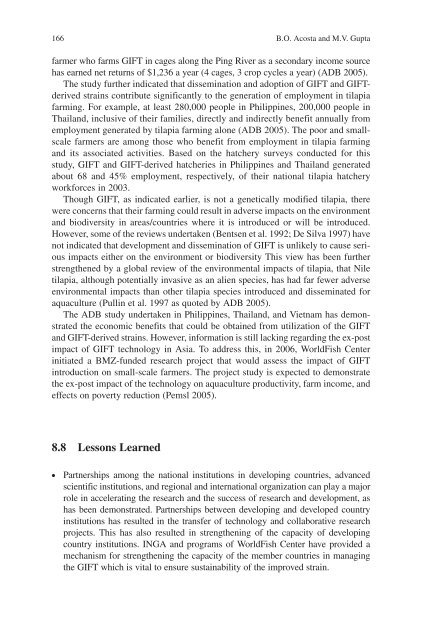Success Stories In Asian Aquaculture - Library - Network of ...
Success Stories In Asian Aquaculture - Library - Network of ...
Success Stories In Asian Aquaculture - Library - Network of ...
- No tags were found...
Create successful ePaper yourself
Turn your PDF publications into a flip-book with our unique Google optimized e-Paper software.
166 B.O. Acosta and M.V. Guptafarmer who farms GIFT in cages along the Ping River as a secondary income sourcehas earned net returns <strong>of</strong> $1,236 a year (4 cages, 3 crop cycles a year) (ADB 2005) .The study further indicated that dissemination and adoption <strong>of</strong> GIFT and GIFTderivedstrains contribute significantly to the generation <strong>of</strong> employment in tilapiafarming. For example, at least 280,000 people in Philippines, 200,000 people inThailand, inclusive <strong>of</strong> their families, directly and indirectly benefit annually fromemployment generated by tilapia farming alone (ADB 2005) . The poor and smallscalefarmers are among those who benefit from employment in tilapia farmingand its associated activities. Based on the hatchery surveys conducted for thisstudy, GIFT and GIFT-derived hatcheries in Philippines and Thailand generatedabout 68 and 45% employment, respectively, <strong>of</strong> their national tilapia hatcheryworkforces in 2003.Though GIFT, as indicated earlier, is not a genetically modified tilapia, therewere concerns that their farming could result in adverse impacts on the environmentand biodiversity in areas/countries where it is introduced or will be introduced.However, some <strong>of</strong> the reviews undertaken (Bentsen et al. 1992 ; De Silva 1997) havenot indicated that development and dissemination <strong>of</strong> GIFT is unlikely to cause seriousimpacts either on the environment or biodiversity This view has been furtherstrengthened by a global review <strong>of</strong> the environmental impacts <strong>of</strong> tilapia, that Niletilapia, although potentially invasive as an alien species, has had far fewer adverseenvironmental impacts than other tilapia species introduced and disseminated foraquaculture (Pullin et al. 1997 as quoted by ADB 2005) .The ADB study undertaken in Philippines, Thailand, and Vietnam has demonstratedthe economic benefits that could be obtained from utilization <strong>of</strong> the GIFTand GIFT-derived strains. However, information is still lacking regarding the ex-postimpact <strong>of</strong> GIFT technology in Asia. To address this, in 2006, WorldFish Centerinitiated a BMZ-funded research project that would assess the impact <strong>of</strong> GIFTintroduction on small-scale farmers. The project study is expected to demonstratethe ex-post impact <strong>of</strong> the technology on aquaculture productivity, farm income, andeffects on poverty reduction ( Pemsl 2005) .8.8 Lessons Learned● Partnerships among the national institutions in developing countries, advancedscientific institutions, and regional and international organization can play a majorrole in accelerating the research and the success <strong>of</strong> research and development, ashas been demonstrated. Partnerships between developing and developed countryinstitutions has resulted in the transfer <strong>of</strong> technology and collaborative researchprojects. This has also resulted in strengthening <strong>of</strong> the capacity <strong>of</strong> developingcountry institutions. INGA and programs <strong>of</strong> WorldFish Center have provided amechanism for strengthening the capacity <strong>of</strong> the member countries in managingthe GIFT which is vital to ensure sustainability <strong>of</strong> the improved strain.
















